 I get spoiled by my friends, and totally undeservedly at that. Last Thursday, the 16th October 2008, El Presidente, Bernie Sim, invited me (and the Stockbroker) to attend the IWFS board dinner he was hosting at Je Suis Gourmand. It was a night of mature wines of some of Burgundy's top makers, all from heralded vintages. I arrived early and waited outside with a Campari soda and some appetizers (courtesy of Marc) to accompany me while I waited for the board members to finish their business.
I get spoiled by my friends, and totally undeservedly at that. Last Thursday, the 16th October 2008, El Presidente, Bernie Sim, invited me (and the Stockbroker) to attend the IWFS board dinner he was hosting at Je Suis Gourmand. It was a night of mature wines of some of Burgundy's top makers, all from heralded vintages. I arrived early and waited outside with a Campari soda and some appetizers (courtesy of Marc) to accompany me while I waited for the board members to finish their business.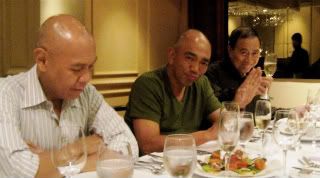 The Stockbroker arrived as the meeting ended and we both joined the members of the board in the bar area reserved for their dinner. Aside from Bernie, in attendance were Oscar Ong, Freddie Wieneke, Rene Fuentes, Sunny Garcia, Fil Juntereal, Dong Puno, Freddy Pio de Roda, as well as Uncle David who arrived a little later. Markus Ruckstuhl and Bill
The Stockbroker arrived as the meeting ended and we both joined the members of the board in the bar area reserved for their dinner. Aside from Bernie, in attendance were Oscar Ong, Freddie Wieneke, Rene Fuentes, Sunny Garcia, Fil Juntereal, Dong Puno, Freddy Pio de Roda, as well as Uncle David who arrived a little later. Markus Ruckstuhl and Bill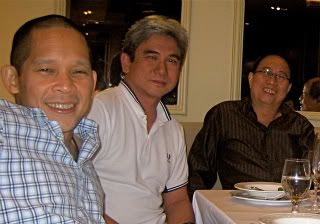 Stone, unfortunately, were absent.
Stone, unfortunately, were absent.After the usual pleasantries, more plates of appetizers and some welcome glasses of bubbly (Ruinart Blanc de Blanc and 1995 Taittinger Comtes de Champagne), things got serious. Marc's servings are generous, so I took the precaution of eating a very light lunch that day - and it's a good thing I did.
~ oOo ~
With a whole serving each of Homemade Duck Foie Gras Terrine with Salad & Toasted Baguette:
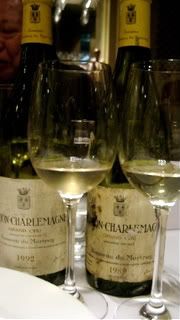 1992 & 1989 Bonneau du Martray Corton Charlemagne Grand Cru - Corton Charlemagne is a grand cru appellation (the top rank in Burgundy terms) that spans the communes of Aloxe-Corton, Ladoix-Serrigny and Pernand-Vergelesses in the Côte de Beaune, the wines of which (100% chardonnay) are noted for structured elegance, length, balance and refined steely/minerally fruit that develops a pronounced spicy-nuttiness with proper age. Bonneau du Martray is recognized as one of the very best makers of the area together with Coche-Dury and Faiveley among others.
1992 & 1989 Bonneau du Martray Corton Charlemagne Grand Cru - Corton Charlemagne is a grand cru appellation (the top rank in Burgundy terms) that spans the communes of Aloxe-Corton, Ladoix-Serrigny and Pernand-Vergelesses in the Côte de Beaune, the wines of which (100% chardonnay) are noted for structured elegance, length, balance and refined steely/minerally fruit that develops a pronounced spicy-nuttiness with proper age. Bonneau du Martray is recognized as one of the very best makers of the area together with Coche-Dury and Faiveley among others.The 1992 initially displayed broad, rich fruit touched with toasty-oak, nuttiness and good weight mid-mouth (the fruit driven-ness seemed to put on the brakes a little past mid-mouth). It lightened up significantly after a few minutes in glass, turning much more minerally, picking up discreet citrus notes and displaying a flinty-steeliness vaguely reminiscent of Chablis but for the alluring mildly spiced, toasty-wood-nuttiness.
The 1989 was marginally, but noticeably less broad mid-palate than the 1992, and had tenser/nervy character (this is not a bad thing) and, towards the back and finish, more apparent citrus notes. Comparatively not as forward than the 1992, this was a more intellectual wine, demanding more attention and thought. I found the structure of the 1989 better, but the 1992 more immediately pleasing.
~ oOo ~
With an absolutely delicious dish of Sautéed Fresh Lobster with Fresh Chantrelles & Shallot Fondue:
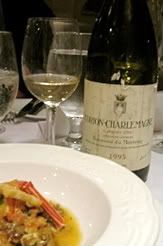 1995 Bonneau du Martray Corton Charlemagne Grand Cru - This was served several minutes after the two previously mentioned wines. Initially, the 1995 was comparatively mute and diffuse compared with the 1992 and 1989; to the point that the Stockbroker and I ranked these Corton Charlemagnes, in descending order: 1992, 1989, 1995. Just to be sure, I set the glass aside for a while so that it had as much "glass time" as the first two.
1995 Bonneau du Martray Corton Charlemagne Grand Cru - This was served several minutes after the two previously mentioned wines. Initially, the 1995 was comparatively mute and diffuse compared with the 1992 and 1989; to the point that the Stockbroker and I ranked these Corton Charlemagnes, in descending order: 1992, 1989, 1995. Just to be sure, I set the glass aside for a while so that it had as much "glass time" as the first two.After around 20 minutes, I revisited it and my patience was rewarded with a plumper, sweetly perfumed nectar of white flowers, riper fruit, a bit of lemon cream and mild vanilla/oak-spicy-toastiness - more forward fruit and apparent wood, less minerality and nutiness than the previous two. This eventually turned into a more crowd-pleaser-styled wine which would probably draw higher scores from professional reviewers.
 1996 Leflaive Bâtard-Montrachet Grand Cru - One of the top appellations of the Côte de Beaune, the vineyards of which are located within the communes of Chassagne-Montrachet and Puligny-Montrachet, just below that of the pinnacle of white wine, Le Montrachet. The wines from this area are known for their generosity, lushness, richness and a biscuity-nuttiness that comes with some age. They are generally known and often chosen to pair with rich, buttered, often times cream-touched, lobster and other relatively robustly flavored/textured shellfish dishes (like the ubiquitous thermidore, for example). Leflaive, together with Ramonet, Sauzet and Niellon, are considered by most to be the very best makers of Bâtard-Montrachet.
1996 Leflaive Bâtard-Montrachet Grand Cru - One of the top appellations of the Côte de Beaune, the vineyards of which are located within the communes of Chassagne-Montrachet and Puligny-Montrachet, just below that of the pinnacle of white wine, Le Montrachet. The wines from this area are known for their generosity, lushness, richness and a biscuity-nuttiness that comes with some age. They are generally known and often chosen to pair with rich, buttered, often times cream-touched, lobster and other relatively robustly flavored/textured shellfish dishes (like the ubiquitous thermidore, for example). Leflaive, together with Ramonet, Sauzet and Niellon, are considered by most to be the very best makers of Bâtard-Montrachet.Rene thunderously proclaimed the Bâtard a better match with the lobster dish than the '95 Corton Charlemagne. Everyone seemed to have agreed - the former's comparatively greater breadth, weight, richness, creamier, riper, biscuity fruit,
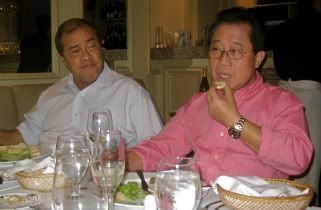 buttery/vanilla notes and over-all generosity simply ran with the dish.
buttery/vanilla notes and over-all generosity simply ran with the dish.Actually, come to think of it, even if somebody disagreed, nobody, in all likelihood, would have bothered to rebut the redoubtable Sr. Fuentes. I mean, the resultant otic damage just wouldn't be worth it.
~ oOo ~
With Roasted Duck Magret with Jus Roti & Crispy Celeriac & Potato Hay:
 2003 Michel Gros Vosne Romanée Premier Cru Clos des Reas - I actually visited this walled vineyard in October of 2007; it's situated down the road, facing the Place de Marie, across the street from Leroy's Les Genevrières, in the sleepy town of Vosne-Romanée. My wife and I stayed at his cousin's, Anne's, maison a few houses down the street. Vosne-Romanée (pronounced: "vohn roh-ma-nay") is located in the Côte de Nuits ("koht du nwee"), the predominantly red wine producing northern part of Burgundy's Côte d'Or. Beaune is an easy 15 minutes' drive south. Clos des Reas is a monopole of Michel Gros, which means only he owns it.
2003 Michel Gros Vosne Romanée Premier Cru Clos des Reas - I actually visited this walled vineyard in October of 2007; it's situated down the road, facing the Place de Marie, across the street from Leroy's Les Genevrières, in the sleepy town of Vosne-Romanée. My wife and I stayed at his cousin's, Anne's, maison a few houses down the street. Vosne-Romanée (pronounced: "vohn roh-ma-nay") is located in the Côte de Nuits ("koht du nwee"), the predominantly red wine producing northern part of Burgundy's Côte d'Or. Beaune is an easy 15 minutes' drive south. Clos des Reas is a monopole of Michel Gros, which means only he owns it. 2003 was a very hot year in Bugundy, yielding wines riper and sweeter than usual. I recall Anne (the most well-known of the three winemaker-siblings) saying one had to take extra care in producing a balanced wine. I had a quick discussion with Bernie about 2003s, generally and collectively, being categorized more of vin du millésime than vin de terroir. This, like most, was clearly one of the former.
2003 was a very hot year in Bugundy, yielding wines riper and sweeter than usual. I recall Anne (the most well-known of the three winemaker-siblings) saying one had to take extra care in producing a balanced wine. I had a quick discussion with Bernie about 2003s, generally and collectively, being categorized more of vin du millésime than vin de terroir. This, like most, was clearly one of the former. Just a touch of animal and truffle to its richly ripe, sweet-spicy dark fruit, black cherry, raspberry, kirsch, violets with a discreet undertone of black coffee. After some time in the glass, it seemed to get sweeter and developed dark chocolate and sweet cola notes more pronounced than most red Burgundies I've tried. I normally find pronounced cola and chocolate notes more in California and Oregon pinot noirs than red Burgundy.
Just a touch of animal and truffle to its richly ripe, sweet-spicy dark fruit, black cherry, raspberry, kirsch, violets with a discreet undertone of black coffee. After some time in the glass, it seemed to get sweeter and developed dark chocolate and sweet cola notes more pronounced than most red Burgundies I've tried. I normally find pronounced cola and chocolate notes more in California and Oregon pinot noirs than red Burgundy.Long, broad, rounded, succulent, almost jammy and chewy with a provocative, lusty personality; it is
 much more of a modern-styled, hedonistic wine than a classic, contemplative one.
much more of a modern-styled, hedonistic wine than a classic, contemplative one.That said, not all wines have to be contemplative or intellectual. Indeed, they shouldn't all be one or the other; else vinous ennui set in. I, personally liked it a lot, and I recall Fil did too. Sometimes, one just has to kick back and enjoy.
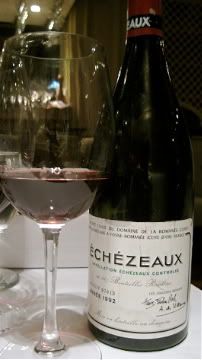 1992 Domaine Romanée-Conti Échézeaux Grand Cru - What a treat. A grand cru from the legendary Domaine de la Romanée-Conti. My wife and I strolled past these vineyards, including La Tâche, DRC, Aux Reignots, etc. just a couple of hundred yards from Anne's place. I understand that part of Échézeaux lies closer to the border of Clos de Vougeot (strange, I drove to the latter and walked around as well and, though it was a very short drive, it seemed a bit far for walking).
1992 Domaine Romanée-Conti Échézeaux Grand Cru - What a treat. A grand cru from the legendary Domaine de la Romanée-Conti. My wife and I strolled past these vineyards, including La Tâche, DRC, Aux Reignots, etc. just a couple of hundred yards from Anne's place. I understand that part of Échézeaux lies closer to the border of Clos de Vougeot (strange, I drove to the latter and walked around as well and, though it was a very short drive, it seemed a bit far for walking).This was (obviously) more classic, not terribly concentrated or ripe, clearly an earth-driven vin de terroir, displaying that distinctive and fatally seductive sweetish Burgundy decay of old
 violets, truffle and compost, as well as clean, pure, earthiness to the delicate and elegant red fruit, dark cherry and raspberry. Rene opined that it was more food-friendly than the younger, riper, sweeter Clos des Reas, and, of course, I agree. Be it red or white, I generally find drier wines more food friendly, except with dessert or foie gras, naturally.
violets, truffle and compost, as well as clean, pure, earthiness to the delicate and elegant red fruit, dark cherry and raspberry. Rene opined that it was more food-friendly than the younger, riper, sweeter Clos des Reas, and, of course, I agree. Be it red or white, I generally find drier wines more food friendly, except with dessert or foie gras, naturally.I didn't take my time with this as it seemed at the cusp of decline; and it's a good thing I did. The last sips I waited on for academic purposes seemed to fade quickly. The finish, though decently long with trailing violets, eventually turned drying, leaving a "furry" feel on the tongue.
~ oOo ~
With Grilled Marinated US Black Angus Côte de Boeuf with Bone Marrow & Red Wine Jus & Lyonnaise Potatoes:
 1993 Domaine Jean Grivot Vosne-Romanée Premier Cru Les Beaux Monts - Another great treat as I do favor the wines from this particular premier cru vineyard (note: those looking for good QPR should look into the 2006 Beaux Monts of Domaine Daniel Rion which I tasted from barrel last year - really good stuff). Wines from this vineyard are normally, demurely rounded, smoothly user friendly and dark spice/red fruit dominated. They also can be enjoyed relatively younger, but can keep for many years - as ably demonstrated by this particular representative.
1993 Domaine Jean Grivot Vosne-Romanée Premier Cru Les Beaux Monts - Another great treat as I do favor the wines from this particular premier cru vineyard (note: those looking for good QPR should look into the 2006 Beaux Monts of Domaine Daniel Rion which I tasted from barrel last year - really good stuff). Wines from this vineyard are normally, demurely rounded, smoothly user friendly and dark spice/red fruit dominated. They also can be enjoyed relatively younger, but can keep for many years - as ably demonstrated by this particular representative.Looking at the menu and pairing wines, I suspected that the steak would over-power this 15 year-old premier cru. I hadn't before tried a Beaux Monts this old, and, based on previous experience, didn't expect it to be able to age well enough over 15 years to stand up to rib steak. Thankfully, my suspicion proved to be baseless, due to the wine's surprising youthfulness (also noted by Bernie and the Stockbroker) and Marc's expert hand in making the steak taste and feel lighter and more delicate than any side of beef I've ever had.
Clean, pure darkly spiced, mildly earthy red fruit, cherry, underlying red beet; nice concentration but not over-the-top, judicious extraction, good push, great balance, with a vaguely seductive touch of violets. Great typicity. Loved it. This could go for more years, but I wouldn't be able to keep my hands off it if I had any.
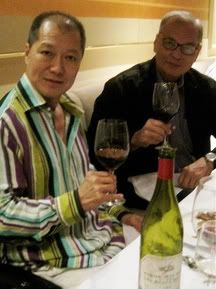
~ oOo ~
To go with the Refined Roquefort with Walnut Bread and the dessert course of Nage de Fruits á la Mode:
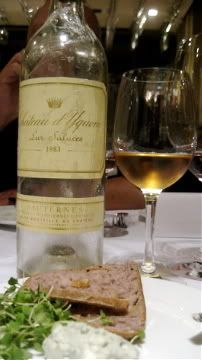 1983 Château d'Yquem - Textbook pairing for the "refined" roquefort. I am unsure why the cheese was described as refined, probably because it was quite mild for a roquefort, and not as creamy or bleu as usual. Good that it was, though, as the '83 Yquem was quite elegantly reserved and unusually short (for an Yquem), without the usual luxurious richness, expansiveness and push one would expect from Yquem from a good Sauternes vintage. Make no mistake, it was very nice and I enjoyed it, but I couldn't help but compare it to the Stockbroker's viscous sex-bomb of a 1983 Rieussec we enjoyed a few years ago which seemed a lot fuller, with a notably healthier dose of botrytis. We spoke about the wine briefly and had similar thoughts about it.
1983 Château d'Yquem - Textbook pairing for the "refined" roquefort. I am unsure why the cheese was described as refined, probably because it was quite mild for a roquefort, and not as creamy or bleu as usual. Good that it was, though, as the '83 Yquem was quite elegantly reserved and unusually short (for an Yquem), without the usual luxurious richness, expansiveness and push one would expect from Yquem from a good Sauternes vintage. Make no mistake, it was very nice and I enjoyed it, but I couldn't help but compare it to the Stockbroker's viscous sex-bomb of a 1983 Rieussec we enjoyed a few years ago which seemed a lot fuller, with a notably healthier dose of botrytis. We spoke about the wine briefly and had similar thoughts about it.Still and all, it is always a great treat to have an aged Yquem from a heralded vintage, and I am more than thankful for the opportunity to try it at this stage of is development. Not the kind of Yquem I expected, but still a very good Sauternes, elegantly reserved, impeccably poised, good acidic balance, firm structure.
As the evening wound down, my wife arrived from her dinner at Le Régalade with her childhood friend, Apple. She was invited to join us and, lucky her, Bernie made sure she was able to enjoy some of the Beaux Monts.

A million thanks for the rarefied dinner and wines, Bernie. I will always remember this evening.
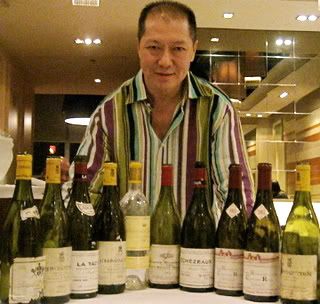




2 comments:
"That said, not all wines have to be contemplative or intellectual. Indeed, they shouldn't all be one or the other; else vinous ennui set in. I, personally liked it a lot, and I recall Fil did too. Sometimes, one just has to kick back and enjoy."
Yes, Noel, just kick back and enjoy. Hehe. Just kidding. Us wine beginners benefit greatly from your obvious passion for wine.:-)
Hi, Chinkee. Yes, sage advice which I shall try to heed. I usually just enjoy and not bother to analyze when drinking wines I've already reviewed/re-reviewed recently or those I have many bottles of.
However, if it's something I've not tried before or haven't had in a long time, I just can't help but over-analyze.
It's a sickness, I tell you! A sickness!
Heh heh.
N
Post a Comment